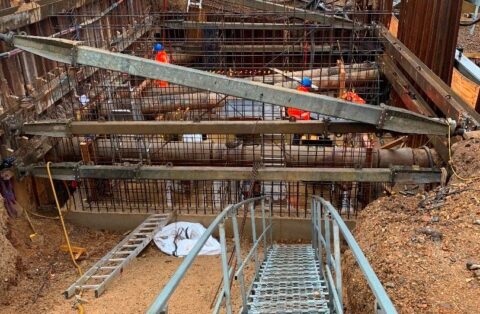The new TT Plant was required as monthly testing, completed by the EA, highlighted that the temporary system was close to failure and could not cope with the rising capacity demands and possible flood risks.
Scope of works included:
- Building a 8m x 6m wet well
- Installation of 3 new pumps
- Below & above ground pipework
- Positioning of 2 Hydrok tanks onto a new concrete slab
- Installation of control panels, telemetry & electrical power
During the excavation works, the team had to move a number of existing cables that crossed the footprint of the new tank and identified pipework that would be incorporated into the new system. They were also required to set up pumps to deal with significant groundwater ingress, which increased during rainfall.
Temporary works were also required due to the location of several underground concrete elements, that were fixed between an existing part of the site and an entrance road. The road was used by heavy sludge wagons, and so the temporary works ensured the safety of our teams and enabled the site to continue operations with as little impact as possible.
On completion of the new wet well, the team began installing the pipework, which included the treated effluent return pipe and the backwash return pipe. The team then poured the new slab for the two Hydrok tanks and once cured, the units were positioned, and the outlet side was connected.
Steelwork stairways and walkways were installed to allow access to the new Hydrok units, and a number of valves and two flow meters were installed to monitor the flows going in and out of the plant.
As the scheme reached commissioning, all of the pipework was pressure tested to ensure they were working correctly and achieving the required outputs. The pumps, actuated valves and flow meters were also tested, and the motor control panels were installed, ready for programming. Training was carried out by Stonbury, on the correct use of the panels.
Since completing the scheme and handing the site back to the client, additional works have been requested. This includes new lighting and the modification of the manually operated penstock, to become automated with a traffic light warning system. This will reduce the risk of manual handling on-site and will alert the site operatives in advance, if there is a problem, without relying on visual checks alone.










